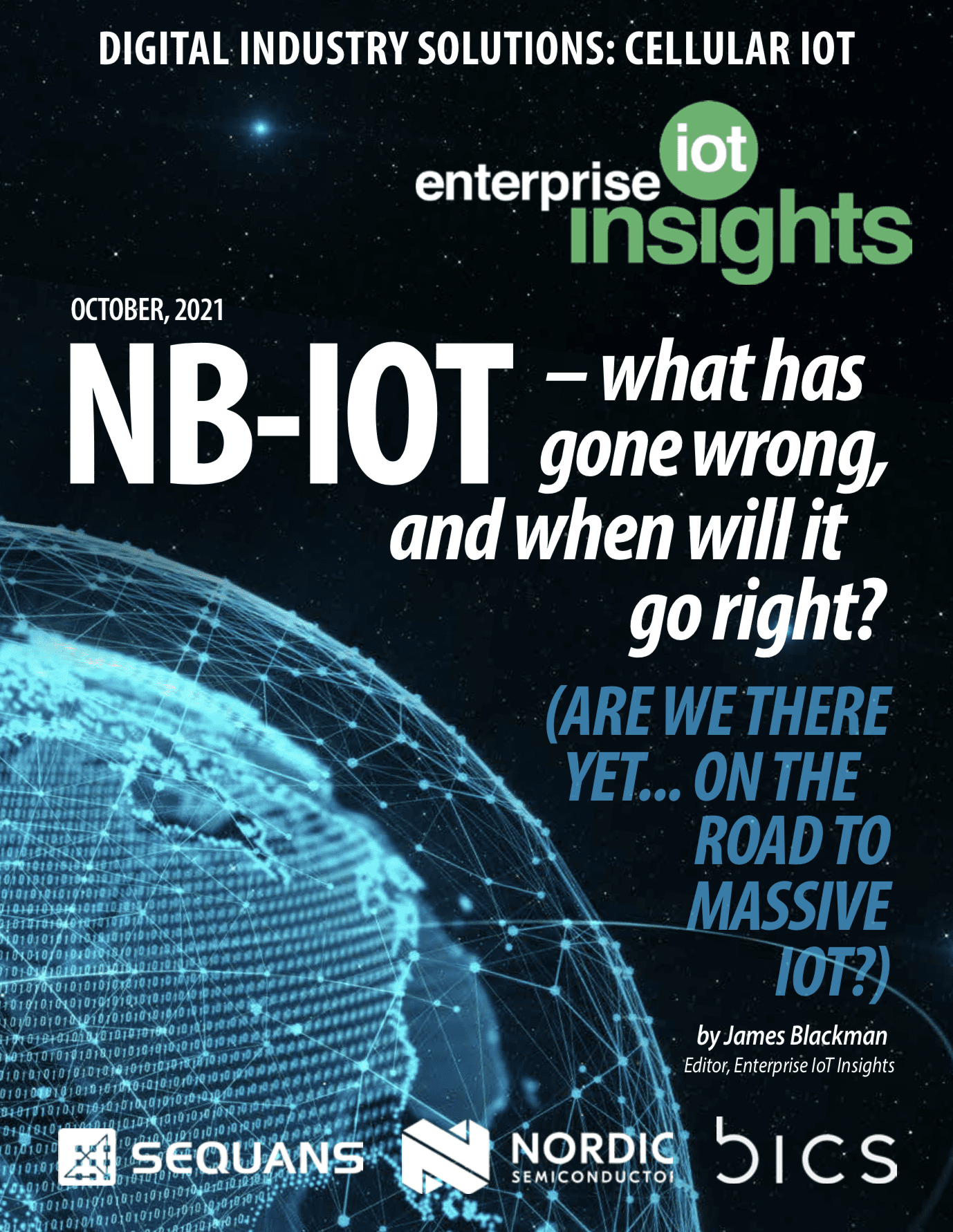Note, this article is taken from a new report, entitled NB-IoT – what has gone wrong, and when will it go right? The full report is available here. A webinar on the same topic is available here, with panellists from BICS, Sequans, and Nordic Semiconductor.
1 | ROAMING COVERAGE
IoT roaming is being sorted, the story goes. And yet it has been a long road to get here, and there is hard-going ahead. Part of the problem is just with coverage; NB-IoT is running at about twice the rate of LTE-M, in terms of deployments, but there is still not enough of it on the international telecoms scene for enterprises to release truly global IoT solutions, without considerable planning and negotiation. “Availability is still patchy,” says Adarsh Krishnan, research analyst at ABI Research.
It seems strange, at a glance, to understand the importance of roaming for NB-IoT, which is preferred for static low-power fit-and-forget sensor installations. LTE-M offers proper mobility, and handover between masts; NB-IoT does not. But even occasional inter-country handshakes between sensors and masts offers a valuable readout about the location and condition of goods.
 More importantly, global manufacturers, with the kind of international contracts that will come to underpin massive IoT, want to build once — in anonymous factories where labour is cheap – and deploy everywhere in the world, provisioning their devices for airtime market-by-market in easy-to-use cloud management platforms. Proper global roaming — as well as iSIM functionality, and probably incoming Cat-NB2 grade capabilities (see below) – is urgently required, and the progress by virtual operators (MVNOs), as well as some proper MNOs, is still not enough.
More importantly, global manufacturers, with the kind of international contracts that will come to underpin massive IoT, want to build once — in anonymous factories where labour is cheap – and deploy everywhere in the world, provisioning their devices for airtime market-by-market in easy-to-use cloud management platforms. Proper global roaming — as well as iSIM functionality, and probably incoming Cat-NB2 grade capabilities (see below) – is urgently required, and the progress by virtual operators (MVNOs), as well as some proper MNOs, is still not enough.
More NB-IoT networks need to be deployed and more NB-IoT roaming deals need to be signed. “The technology is global, but the deployments are regional, still. The roaming situation still isn’t great. If you want to track sheep across the border from Norway to Finland, you still need to negotiate with two operators,” says Svein-Egil Nielsen at Nordic Semiconductor. “Yes, you can do it, if you are using an MVNO. But it still isn’t as smooth as we thought it would be five years ago. It is not like roaming with GSM with your phone.”
Vodafone agrees; but its emphasis is on the ground already covered, rather than the road to go. “It is about making it dead easy to adopt – which is where we are getting to. Enterprises want predictable connectivity and security – so that if they deploy it in one country, it is easy to roam into another, and to the next and the next. It is like we have finally established a common field for everyone to play on – whereas before they were just playing around in their own little sandpits. We are all going the same way; that is the maturity we are seeing with NB-IoT now.”
2 | INTEROPERABILITY FIXES
The point above, that NB-IoT is a global technology (deployed regionally), is not exactly true. Because technical discrepancies between regional deployments also undermine its global promise by impacting interoperability – when roaming between markets, and even, potentially, when roaming on disjointed network infrastructure in-market. In general, cellular roaming is well standardised by the GSMA, technically and commercially. But certain NB-IoT features complicate the picture: specifically, two functions designed to save and conserve battery power.
 These functions, power saving mode (PSM) and extended discontinuous reception (eDRX), an NB-IoT device to, respectively, turn off its radio module while at the same time remaining registered to the network, and deactivate from listening to the network. But neither function is technically aligned across NB-IoT in LTE network deployments. Operators configure their PSM and eDRX timers in their networks differently in order to orchestrate power consumption (sleep/hibernate schedules) for whichever applications dominate in their territories.
These functions, power saving mode (PSM) and extended discontinuous reception (eDRX), an NB-IoT device to, respectively, turn off its radio module while at the same time remaining registered to the network, and deactivate from listening to the network. But neither function is technically aligned across NB-IoT in LTE network deployments. Operators configure their PSM and eDRX timers in their networks differently in order to orchestrate power consumption (sleep/hibernate schedules) for whichever applications dominate in their territories.
This misalignment – this technical inconsistency and conflict – poses challenges for network interoperability when roaming with NB-IoT devices. And there is no easy way around. “There are still some challenges for companies to deploy devices with a simple configuration of PSM and eDRX across multiple countries. That still requires some decision and compromise by the enterprise. So there is some complexity, and I don’t know how the mobile operators will resolve it – because it is very much about the radio network configuration,” comments Luc Vidal-Madjar at BICS.
There is more, too. These functions bring a drawback, as well, as an IoT device in PSM or eDRX mode cannot be contacted from the network side, which impacts crucial eSIM and iSIM (eUICC / iUICC) functionality in NB-IoT, and potentially even deactivates the SIM function — and as a consequence typically requires the sensor unit to house a secondary radio module, normally to connect to 2G, a for initial contact and further provisioning.
3 | COST CALCULATIONS
This appears, from the meta-narrative in this report, to have been remedied; but rather like with the challenge of roaming, the solution has only just revealed itself and there is still work to do for the whole of the cellular industry to observe the picture. And as with everything, it is behind the curve on the business case; the rival non-cellular IoT market has been hammering out the total-cost-of-ownership (TCO) equation with enterprises since the middle of last year, at least. Better late than never; but it represents more lost-ground to the likes of LoRaWAN and Sigfox.
The question of TCO is dealt with on the previous pages; between them, Nordic Semiconductor, an IoT chipmaker in the IoT module game as well, and Vodafone Business, the enterprise division of a tier-one carrier that looks untroubled by the 5G hype, appear to settle on a ballpark fee for NB-IoT tracking and monitoring solutions. In the space of about 18 months, Vodafone has gone from short-term roaming ‘settlements’ (negotiated retrospectively as, “how many have you got and how many have we got?”) to more formal arrangements in 55 markets, and counting.
 More crucially, it has settled on rock-bottom airtime fees, with the bidding starting at €12.99 for 10 years; its grandcentrix development house in Cologne, acquired in 2019, is bundling airtime costs into bespoke NB-IoT solutions for enterprises, it reckons, and its outlook has shifted 180 degrees on IoT, compared with traditional airtime sales. The philosophy, which still sounds like marketing, is the same co-creation shtick that is supposed to bridge the IT/OT divide in Industry 4.0 – which says enterprises are ‘partners’ and not just ‘customers’ anymore.
More crucially, it has settled on rock-bottom airtime fees, with the bidding starting at €12.99 for 10 years; its grandcentrix development house in Cologne, acquired in 2019, is bundling airtime costs into bespoke NB-IoT solutions for enterprises, it reckons, and its outlook has shifted 180 degrees on IoT, compared with traditional airtime sales. The philosophy, which still sounds like marketing, is the same co-creation shtick that is supposed to bridge the IT/OT divide in Industry 4.0 – which says enterprises are ‘partners’ and not just ‘customers’ anymore.
But this new consultancy approach to sales is only really novel to mobile operators; as suggested, even in the IoT space, most of the industry has been discussing the minutiae of TCO for some time. Which is probably why Nordic Semiconductor, with the kind of red line on profit margins that stops it from entering China, is the one in this exercise to quote an easy TCO figure – $50 for hardware, airtime, and application. Hardware pricing is important; the lower it goes the more that gets connected. But understanding the value IoT delivers is more important.
And as NB-IoT hardware prices continue to fall in China, they appear to have stabilised everywhere else at a level that works for all sides – for the enterprise user, the airtime provider, the hardware maker, and the solution developer. “There are all kinds of practical issues with NB-IoT, still. But $50 over 10 years makes sense to the customer, and makes sense to the industry.” So progress is good, then; the challenge is just for the whole of the cellular market to grasp the nettle.
4 | MACHINE LEARNING
The problem with NB-IoT, in the end, is that it is limited. By definition; because it is a narrowband cellular tech for power-constrained IoT devices. Data rates top-out at 200 kbps on the downlink and 20 kbps on the uplink, and payloads peak at 1600 bytes per message – and if you want 10 years of battery life, as advertised, the average daily payload should probably go no higher than 200 bytes. Which presents certain challenges for network transmission and power consumption if the radio unit is to carry any more than very limited and very occasional data transfers.
The discipline, increasingly, for the whole IoT market is to run processing at the ‘edge’, as close to the action as possible. There are several reasons for this. In industrial environments, where latency is often a critical factor for data transfers between connected machines and analytics engines, there is a trend to run traffic over private 4G/5G networks to and from local compute reserves, sometimes inside regional (MEC) infrastructure, mostly on enterprise premises, and at times in the machines themselves.
 In the case of low-power IoT sensors, where the objective is just to stop the network from falling over, the only option is often to embed compute power inside the IoT module, as miniaturised machine learning, or ‘tinyML’. This way, data processing – actually, the process of ‘inferencing’ insights on cloud-trained machine learning (ML) models – happens in the device, where the data is harvested in the first place, and much of the old two-way traffic to the cloud is stopped. Only the anomalies – the events in the data that drive the action – are sent over the network.
In the case of low-power IoT sensors, where the objective is just to stop the network from falling over, the only option is often to embed compute power inside the IoT module, as miniaturised machine learning, or ‘tinyML’. This way, data processing – actually, the process of ‘inferencing’ insights on cloud-trained machine learning (ML) models – happens in the device, where the data is harvested in the first place, and much of the old two-way traffic to the cloud is stopped. Only the anomalies – the events in the data that drive the action – are sent over the network.
These are used to enable centralised control of connected devices, and to further train the ML engine. Meanwhile, the network is unburdened, helping to manage transmission costs and conserve battery power. The tinyML movement is gathering pace; Nordic Semiconductor is working with US based tinyML specialist Edge Impulse to embed ML into its IoT portfolio, including into its Bluetooth-based nRF52/3 series and cellular-based nRF9160 products. “It is even more important in the cellular space, because the transmissions themselves are costly, in terms of power consumption and also data traffic. So it is very relevant for that.”
5 | INTEGRATED SIMS
“NB-IoT limitations give innovators pause,” writes Ireland-based SIM specialist Kigen, spun out of UK chip design company Arm last year. “For almost any business, battery life of 10+ years and the ability to support deployments on a global scale means frequent carrier network changes – a challenging task that requires a physical switch of a SIM card. The alternative: you’re stuck with the same mobile network operator’s coverage blackspots and costs for the device’s lifecycle. The possible solution: remote SIM provisioning (RSP).”
 RSP is the only way the cellular IoT industry is going to “break the scale barrier”, as Vodafone puts it. The GSMA specification for RSP enables remote management of operator profiles in embedded SIM and integrated SIM (eSIM and iSIM) functions. “Successful scaling of IoT requires the integration of RSP and NB-IoT,” notes Kigen. But NB-IoT is not ready; continuing issues with roaming and billing (see above) are holding up multi-market deployments, anyway. More profoundly, NB-IoT does not support the necessary functions to deliver the SIM profile over-the-air.
RSP is the only way the cellular IoT industry is going to “break the scale barrier”, as Vodafone puts it. The GSMA specification for RSP enables remote management of operator profiles in embedded SIM and integrated SIM (eSIM and iSIM) functions. “Successful scaling of IoT requires the integration of RSP and NB-IoT,” notes Kigen. But NB-IoT is not ready; continuing issues with roaming and billing (see above) are holding up multi-market deployments, anyway. More profoundly, NB-IoT does not support the necessary functions to deliver the SIM profile over-the-air.
Remote provisioning is conducted via the SM-SR (subscription manager / secure routing) function using a connectivity ‘bootstrap’ profile; as it stands, the ‘bootstrap’ has to be carried on a standard cellular technology. As well, the ‘bootstrap’ connection activates a ‘handshake’ via SMS, which is also unsupported in NB-IoT. Any IoT device that excludes SMS in order to reduce complexity – by ejecting a stripped-back 2G companion radio, for example – precludes the option of remote provisioning, and over-the-air upgrades.
Not ideal. The workaround is to include module support for an SMS-capable cellular technology, such as 2G or 4G to allow fallback for the execution of RSP related operations. This is how Kigen is getting around the problem, including with a proprietary version of iSIM, ahead of its standardization, which moves the SIM functionality into the device’s permanent hardware array. Kigen was engaged with Altair (Sony Semiconductor) and Vodafone on the Bayer project (see page 32 of report, and online here), notably. Again, progress is being made, but it is interminably slow.
This article is continued here.
Note, this article is taken from a new report, entitled NB-IoT – what has gone wrong, and when will it go right? The full report is available here – or click on image below. A webinar on the same topic is available here, with panellists from BICS, Sequans, and Nordic Semiconductor.


